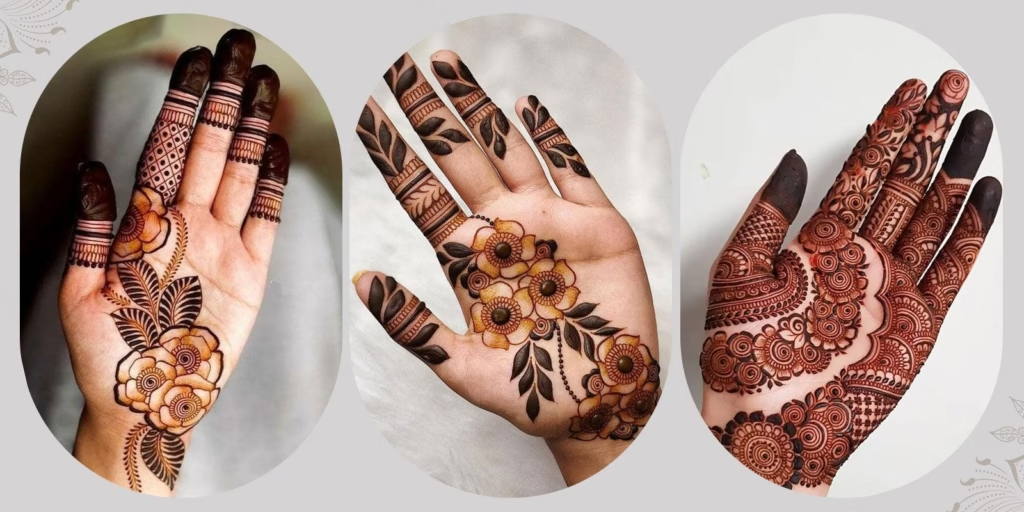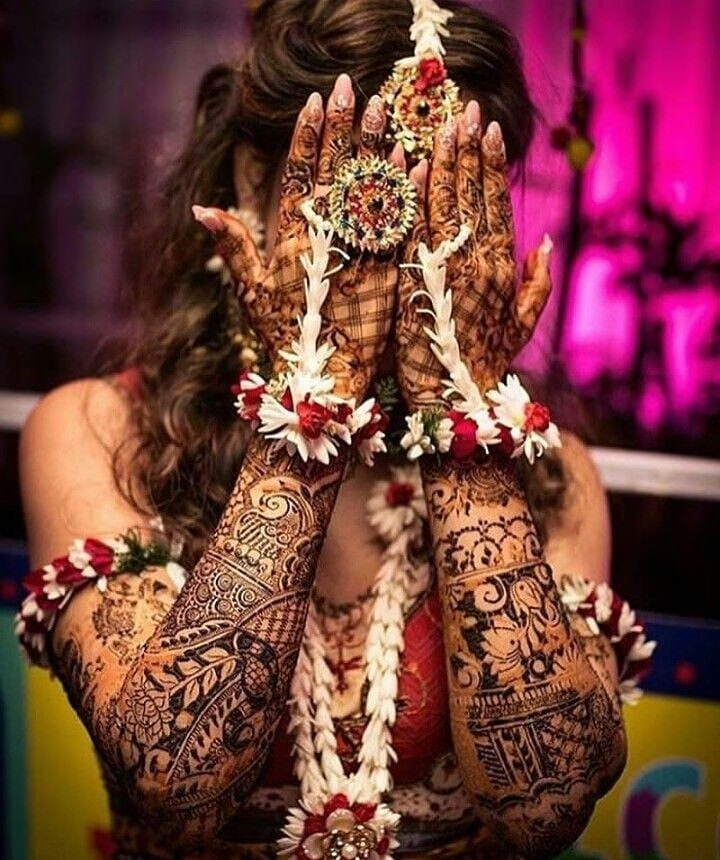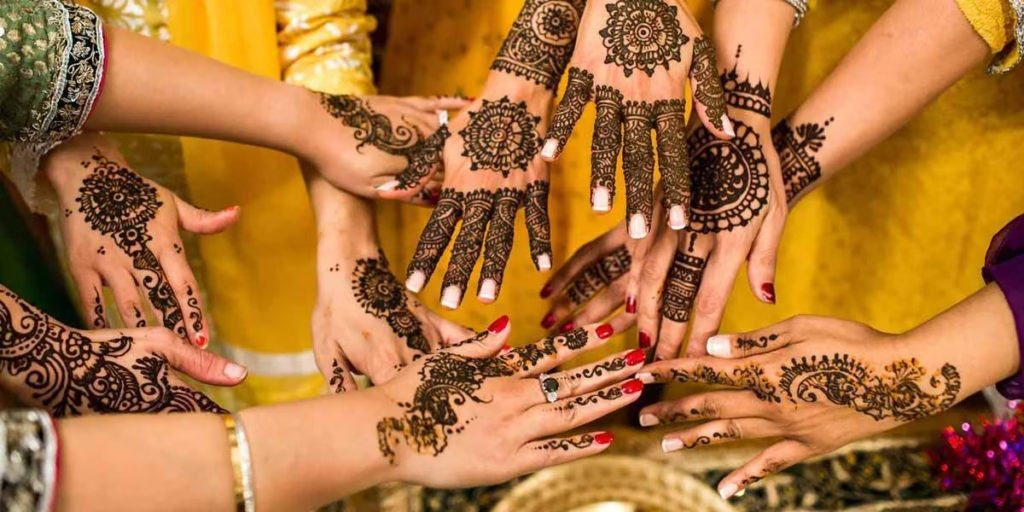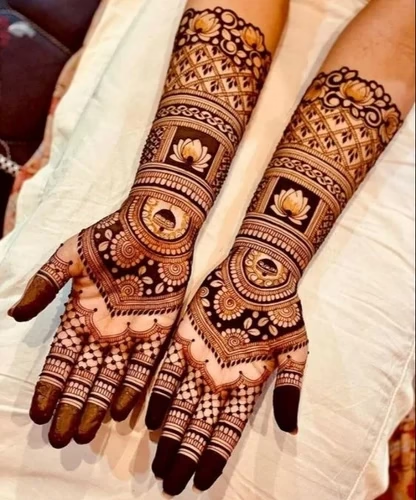What is Mehandi? A Cultural Celebration Through Intricate Designs
What is Mehandi? Mehandi, also known as henna art, is a timeless tradition that embodies cultural significance, artistic expression, and celebration. Mehandi, the substance derived from the henna plant, is used for creating innovative designs when coated on the human body. The custom is imbibed in countless traditions, spanning centuries across South Asia and the Middle East, is testimony to joy, celebration, and uniqueness inside one’s own existence.
Much can be said of the history of mehandi, as diverse as the designs themselves. Going back more than 5,000 years, it is at least that deep when meant for use for cooling in hot climates. Over time, mehandi went from a purely utilitarian function to a more artistic and cultural practice. In many corners of India, a bride will apply a lavish design of mehandi on her hands and feet at their wedding as a symbol of beauty, love, and prosperity wielded by brides. The art has traveled outside its own cultural domain, getting its own share of followers all over the globe with its own complexity and richness.
Perhaps the most fascinating aspect of mehndi is the meaning it carries. Traditional Indian mehandi designs and symbols, from paisleys representing fertility and good fortune to flower designs representing happiness and new life, are saturated with richness. This very symbolism is what makes it beautiful, thus keeping this tradition alive, due to both its aesthetics and cultural significance.
What are the Different Styles of Mehandi? Exploring Regional Variations

Mehandi designs were always niche creations with local orthodox customs, ceremonial greetings, and voila. Today, mehandi patterns have diverged so far apart owing to regionalism, charm, and cultural backgrounds.
Indian Mehandi: This is dense Mehandi with intricate designs, portraying the designs on the hand as well as the feet. Common symbols are paisley, flowers, peacocks, and others that denote wealth and beauty. It is customary for Indian bridal mehndi to be elaborate enough to hide the initials or names of the bride and groom in it.
Arabic Mehandi: Arabic mehandi designs are drawn with bold sweeping patterns that are not as packed as their Indian counterparts. Floral motifs and vine work detailed amidst empty spaces provide a stark contrast to the typical styles of South Asian motifs. It is the simplicity and beauty of the Arabic design that makes it highly regarded and therefore more commonly used in non-bridal and casual functions.
Pakistani Mehandi: An amalgamation of Indian and Arabic designs, this Pakistani Mehandi too deals with intricate work and features bold lines. Most of the time designs are used for religious and cultural rituals with the motifs of domes, flowers, and geometric patterns.
Moroccan Mehandi: Moroccan mehandi patterns tend to be whimsical, geometric shapes with tribal motifs. Generally, they are dominated by diamonds, lines, and other symmetric patterns and originate from Morocco wherein they belong to the domain of rich cultural aspects.
Modern Mehandi: Contemporary Mehandi sprinkled with a dash of traditional styles gives way to Mehandi art. Ranging from minimalist to rather bold irrespective of customer preference, modern Mehandi has many patterns-certainly bordering on unconventional, even some incorporating glitter or colored henna.
Each different style tells a story that shows the cultural identity and artistic expression of the area. From that point onward, Mehandi art is held for all occasions and reasons, from weddings to festivals to ornamental use.
Mehandi for Celebrations: Occasions That Embrace This Beautiful Art Form

There’s something about these occasions that just scream happiness, prosperity, or stirring life. Mehndi plays a different role wherever it is involved. These are some of those occasions where mehndi truly takes centre-stage:
Weddings: Mehandi ceremonies are part of wedding traditions in countries like India, Pakistan, and the Middle East. The bride’s hands and feet are decorated with very intricately designed floral patterns, while the other ladies simplistically apply designs on their hands. Bridal mehndi consists of motifs that symbolically stand for love, prosperity, and fertility.
Festivals: Women and girls adorned their hands with mehndi during festivals like Diwali, Eid, and Karva Chauth. The designs are a representation of the celebration itself and spring forth from the devotion and joy it embodies.
Mehndi Parties: Mehandi parties are trendy pre-wedding celebrations in which family and friends come together to socialize with music, dance, and henna. This is a celebration that signifies a delicate blending of tradition with the modern form of celebration.
Bridal and Baby Showers: It is a contemporary trend for mehndi in bridal and baby showers where guests enjoy henna designs as a blessing for the event.
Religious Ceremonies: In some cultures, mehandi is applied in religious ceremonies and denotes blessing and purification. For instance, henna application during Ramadan and Navratri is considered very auspicious.
The Science Behind Mehndi: How It Works on the Skin
Mehndi is beautiful not only for its artistry in designs but also for the biological processes behind the application. Mehndi is an extract from henna plant, whose scientific name is Lawsonia inermis. The scientific name of mehndi is lawsone-a natural dye molecule that binds with the keratin of our skin, nails, and hairs. This process of binding gives the mehndi its characteristic yellowish-brown or reddish-brown color. The depth of the color is dependent on many factors such as the quality of henna, duration of application, and personal skin chemistry.
Once it has been applied to the skin, the paste infiltrates the skin’s outer layers. This means that, for some three weeks or longer, fine designs will remain quite visible. The depth of color of this hemoglobin is largely a function of the age of the leaves, the drying, and conditions under which the leaves are cultivated in which the dye concentration develops.
For best results, the paste should be kept on the skin for a prescribed number of hours, usually getting even into time frames of 3 to 6 hours for purposes of dyeing. The longer the paste stays on the skin, the darker and more intense will be the stain from this passage of time spent on the skin, since it would enable more lawsone to be tightly bound to the keratin layer.
Moreover, the surroundings are important in the mehndi application process. Moisture and sweat probably make the setting process speedier, hence causing richer shades of color. Some mei-mehndi practitioners will then recommend sealing the henna designs under plastic wrap with good oils such as eucalyptus or tea tree oil for the purpose of creating the warmth and perspiration that encourage the color to develop more saturated.
Naturally derived henna is quite safe-it is the synthetic impersonations that need to be used discerningly. Black henna can contain harmful chemicals, the most notorious being PPD (para-phenylenediamine), which has been implicated in skin irritation, allergic reactions, or skin damage over time. For this reason, sticking to reputed suppliers of natural henna is the only option to guarantee clinical quality.
Popular Myths and Facts About Mehndi
Over the years, many myths about mehndi have emerged, blending cultural beliefs with misconceptions. Let’s explore some popular myths and the truths behind them:
- Myth: Darker mehndi indicates deeper love from your partner.
Fact: The color of mehndi depends on the quality of the henna, skin type, and aftercare. It has no correlation with emotional depth or relationships. - Myth: Mehndi can only be applied during special occasions.
Fact: While mehndi is a staple for festivals and weddings, many people now use it for personal adornment and artistic expression. - Myth: Mehndi is harmful to the skin.
Fact: Natural mehndi is safe and even has cooling properties. However, synthetic or adulterated products can cause irritation.
By separating myths from facts, we can better appreciate the rich heritage and beauty of mehndi.
Global Influence of Mehandi
Originally rooted in South Asian and Middle Eastern traditions, mehndi lost its ownership and became an art form universally recognized and appreciated across the globe. From multicultural weddings to being a stage at global fashion runways, the designs and symbolism encapsulated in mehndi have found acceptance in the most unlikely of settings. Mehndi has developed into a conduit whereby cultures can meet and be represented, attesting to its flexibility and capacity to exist peacefully with the mode and pace of modern life.
Mehndi has found an audience globally, especially on social media networks such as Instagram and Pinterest. Artists show their style and technique through this medium, developing a widely dynamic group of followers who indulge in both traditional designs and contemporary styles while following the trends closely. The hashtag #Mehndi connects waving millions of fans, enabling creativity and intercross-cultural appreciation.
In Western countries, mehndi is mostly seen at the confluence of music festivals, art exhibitions, and pop-up events since it symbolizes an expression of artistic freedom and cultural expeditions. It is also appreciated as one of the modern day, temporary practices in body art among those who do not want to get permanent. It can therefore appeal to a broad audience that is looking for some way of creative self-expression without the concern that a tattoo may last a lifetime.
The incorporation of mehndi into culture around the world is comparable to a fanfare of its universal likeness in art, transcending boundaries. As it is being celebrated, mehndi continues inspiring and conveying the message of cross-cultural integration in a global existence.
How to Create Your Own Mehndi Designs: Tips for Beginners and Enthusiasts
Creating your own mehndi designs can be a rewarding and creative experience. Here are some tips to get you started:
Kick Off with Simple Patterns: Begin with the simplest things like dots and lines and circles. Build up your confidence by gradually working with more complex designs: flowers, leaves, and paisleys, respectively.
Use the Right Tools: Invest in a good quality henna cone to achieve precision in your designs. Alternatively, you could also make your duplex or use a fine paint applicator bottle.
Practice on Paper Before Skin: Draw your designs on paper first before putting mehndi on your skin so that you have better flow and symmetry.
Step-By-Step Approach: Work from the inside out, starting with the inner motif. This is to create balance and proportion in your design.
Experiment with Styles: Try out different regional styles and mix and match parts of designs to make unique designs that represent your personality.
Caring for Your Mehandi: Ensuring Lasting Beauty and Vibrancy
Once your mehndi is applied, proper care can ensure its vibrancy and longevity. Here are some aftercare tips:
- Aftercare: Preserving your mehandi’s beauty and richness for a long time
- With carefully applied aftercare, it actually stays on and lasts longer. Some aftercare tips include:
- Air Dry the Mehandi: Do not touch or wash the mehandi till it has dried naturally. Artificial heat will make your design crack.
- Lemon-Sugar Mix: Once dried, brush the mehandi with a mixture of lemon juice and sugar. This combination really helps darken the color further and keeps the design intact.
- Avoid Water for 24 Hours: Water has a tendency to get rid of mehndi before it sets. Allow the area to dry for a minimum of 24 hours for good results.
- Apply Oil: After the mehndi has dried and been scraped away, apply natural oils like coconut or mustard to hydrate the skin and deepen the color’s intoxication.
- How to Get Mehndi Darker: You can use a steaming heat source in such a way that it directs steam into your body to get your mehndi a richer and darker color, basically gets a better grip of the skin. Let the mehndi sit on your hand for a longer period, preferably four hours for darker coloring. Try to avoid washing hands with soap after removing the dry mehndi paste.
- Keep away from scrubbing agents: Since you want the design to be saved as long as possible, try to stay away from sticky substances, such as soaps, detergents, and scrubbers for a couple of days.
Trust me, with the following hints, you can expect a pigment that’s very dark and long-lasting to make your celebration more jubilant.
By following these tips, you can enjoy a deep, long-lasting mehndi stain that complements your celebration.
Conclusion: Embrace the Art of Mehndi in Your Celebrations and Personal Expression

To many, mehndi is not simply an art form; mehndi is an expression of culture, beauty, and tradition. With rich beginnings and changing styles, mehndi would forever draw millions from corner to corner, from every occasion of wedding to festival to personal embellishments, being centuries-old art it elaborates much on joy, love, and creativity.
By including mehndi in your celebrations, you will be honoring history while keeping alive the delusive beauty of this ancient art. Grab the henna cone; choose which designs you like from among the wide range, and get mesmerized as mehndi brings some grace and meaning into your cherished moments.
For further reading on significance of Mehndi, you can visit these useful resources:
Check out our Blog Page on Traditional Indian art.



Leave a Reply